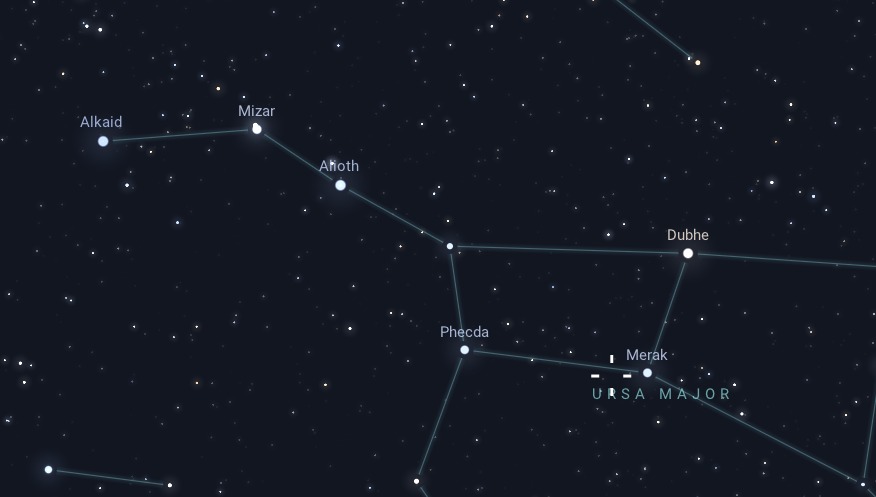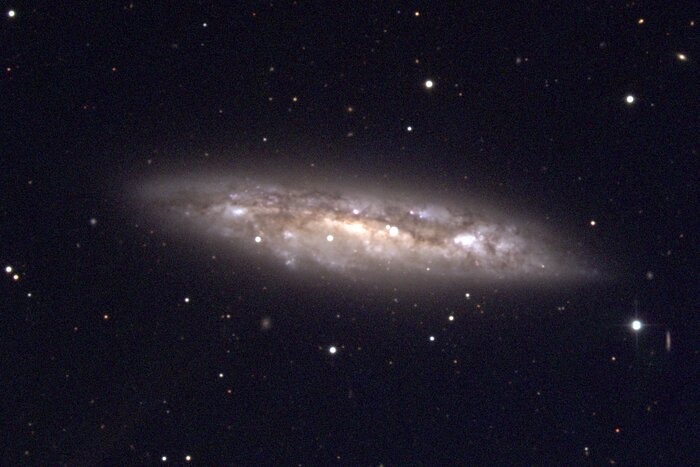M108, also known as Messier 108 or NGC 3556, is a barred spiral galaxy located in the constellation Ursa Major. It was discovered by the French astronomer Pierre Méchain in 1781 and later included in Charles Messier’s catalog of astronomical objects. M108 is one of the more intriguing galaxies due to its structure and orientation relative to Earth, making it an interesting subject for both amateur and professional astronomers.
Physical Characteristics
M108 is classified as a barred spiral galaxy, which means it has a central bar-shaped structure composed of stars. Unlike many other spiral galaxies that are viewed face-on or at a slight angle, M108 is seen almost edge-on from Earth. This orientation provides a unique perspective, showcasing its dark dust lanes and the uneven distribution of its spiral arms.
The galaxy spans about 100,000 light-years in diameter, making it roughly comparable in size to the Milky Way. It is located approximately 45 million light-years away from Earth, based on measurements of its redshift and standard candles like Cepheid variables.
Stellar Population
The galaxy is rich in young, hot blue stars, indicating active star formation, particularly in its spiral arms. These regions of star formation are often marked by bright HII regions, which are clouds of ionized hydrogen gas. These HII regions are energized by the ultraviolet light from young, massive stars, causing them to glow brightly in optical wavelengths. The presence of these regions highlights the ongoing process of star birth within the galaxy.
Active Galactic Nucleus
M108 has been identified as hosting an active galactic nucleus (AGN), which is a region at its centre emitting significantly more radiation than normal. This activity is believed to be driven by a supermassive black hole accreting matter. The AGN in M108 contributes to its classification as a Seyfert galaxy, a type of galaxy with a particularly bright nucleus. Observations across different wavelengths, including radio and X-ray, help in studying the energetic processes occurring in the galaxy’s core.
Interactions and Environment
M108 is part of the M109 Group, a collection of galaxies that includes the prominent barred spiral galaxy the group takes its name from. The interactions within this group can influence the dynamics and evolution of its member galaxies. Gravitational interactions with neighboring galaxies can trigger bursts of star formation and affect the distribution of gas and dust within M108.
The galaxy serves as an important object of study for understanding the dynamics of barred spiral galaxies, particularly those viewed edge-on. Its active nucleus and star-forming regions provide valuable data on the processes driving galactic evolution and the lifecycle of stars. Additionally, studying galaxies like M108 helps astronomers refine distance measurement techniques and improve models of galactic structure and behaviour.
Observation
M108’s position in the constellation Ursa Major makes it relatively easy to locate using the Big Dipper as a reference point. The galaxy has an apparent magnitude of about 10.0, making it visible through medium to large telescopes under dark sky conditions.

The best time to observe the galaxy is during the spring months from March to May. During this period, Ursa Major is high in the sky in the Northern Hemisphere, making M108 more accessible for observation throughout the night. Start at Merak (Beta Ursae Majoris), which is the star at the bottom-right corner of the bowl in Ursa Major. M108 is near this star.
When observing the galaxy, one of the most striking features is its mottled appearance due to the dark dust lanes interspersed with bright star clusters. This texture gives the galaxy a somewhat irregular look when viewed through telescopes. The edge-on orientation also means that the spiral structure is less pronounced than in face-on spirals, but the overall elongated shape is clearly visible.



